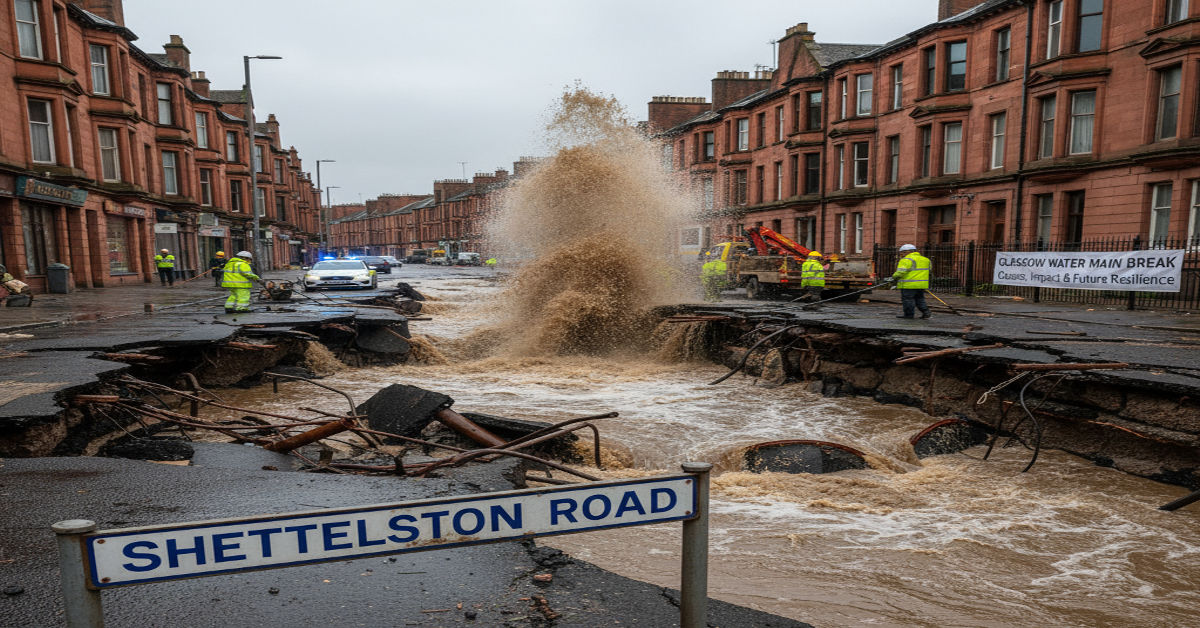In May 2025, a seemingly routine morning in Glasgow was upended when a major water main beneath Shettleston Road ruptured, flooding the street, halting traffic, and leaving many houses without clean running water. That sudden failure exposed how vulnerable modern life is to failures in infrastructure we seldom see or even think about. The shock of seeing water gushing from tarmac brought the invisible into stark relief.
This incident didn’t just inconvenience commuters or frustrate homeowners. It forced utilities, local government, and community leaders into a high-stakes response mode. In this article, we’ll walk through what happened, why it happened, how Glasgow responded and which steps can make future breakdowns less damaging. Along the way, we’ll weave in data, expert perspectives, and practical lessons that other cities can take to heart.
Shettleston Road’s Hidden Role
Shettleston Road lies in Glasgow’s East End, connecting dense residential districts to commercial arteries. At first glance it is just another city thoroughfare. But beneath its surface runs crucial pipelines, including trunk mains that serve broad swathes of eastside neighborhoods. When one of those pipelines failed, the consequences spread well beyond the road itself.
Because Shettleston Road is a conduit not just for cars and buses but also for water, drainage, and subsurface utility systems, any disruption reverberates vertically through layers of urban life. Disruption of a main here means parts of the network upstream and downstream must reconfigure flow. Hence a break under Shettleston Road affects neighbors beyond that strip — streets, blocks, and districts that depend on the same supply chain.
The Day the Main Burst: Event Narrative
The rupture occurred in the early hours of May 29, 2025, beneath the stretch between Old Shettleston Road and Fernan Street near St Mark Street. Residents reported seeing water bubbling through cracks in the road, then surging in volumes that flooded pavements. Within minutes, Shettleston Road was impassable to both vehicles and pedestrians.
The cascade was rapid. Valves had to be isolated, traffic diverted, and local water supply curtailed. Scottish Water confirmed its emergency response teams were on site almost immediately. Local social media lit up with reports of dry taps, low pressure, and discolored water in nearby homes. The immediate aim became damage control: stop flooding, isolate the broken main, and prevent further supply loss.
As hours passed, excavation began. Engineers cut into the road, exposed the failed pipe section, and assessed damage. Replacement materials and fittings were prepared, while crews monitored pressure and flow in adjacent sections to maintain minimal service where possible. With the broken section removed and new pipe installed, they began phased restoration of flow and flushing. Still, some areas faced continuing low pressure or murky water for up to 48 hours after the initial break.
Why It Happened: Vulnerabilities Exposed
A tragic burst seldom results from a single cause. In this case, several interlocking vulnerabilities appear to have converged.
First, aging infrastructure loomed as a primary suspect. Much of Glasgow’s pipe network dates back decades, with cast iron or early steel pipes prone to internal corrosion, pitting, and weakening over time. A pipe section weakened by years of wear becomes more susceptible to failure under stress.
Second, hydraulic disturbances play a hidden but powerful role. Sudden surges or pressure fluctuations — triggered by valve closures, pump cycles, or demand spikes — can exert forces that exceed the pipe’s residual strength. In a weakened pipe, even a modest pressure wave may be enough to tip it past its breaking point.
Third, ground conditions matter. Soil swelling, contraction, freeze-thaw cycles, or nearby excavation can shift pipe bedding or create stresses at joints. Vibrations from nearby heavy traffic or construction can also contribute incremental wear. Over years, those stresses accumulate.
Lastly, external factors — such as poorly coordinated utility works, micro-movements in the earth, or changing usage patterns — may have pushed a marginal section over the limit. The Shettleston break likely resulted from the interaction of material degradation, operational stresses, and environmental pressures acting in concert.
Ripple Effects: Residents, Health & Business
When water supply fails, consequences ripple quickly from infrastructure to human lives. In the affected G32 postcode and surrounding neighborhoods, many households lost water entirely. Others endured extremely low pressure or intermittent flow that made simple tasks like washing, flushing, or cooking a struggle.
Discolored water commonly followed restoration. Sediment, rust, or entrapped air in pipelines can discolor water until it’s flushed out. Officials urged residents to run cold taps until clarity returned. Although the water was declared safe once tests passed, psychologically the uncertainty unsettled many, especially families with young children or immunocompromised members.
Local businesses faced parallel stress. Restaurants, laundries, cafés, barbershops — many operations that rely heavily on water — were forced to reduce hours or close altogether during the break. Customer footfall declined as access was limited and services disrupted. Some businesses lost inventory or perishable goods due to water-dependent processes. In dense commercial corridors like Shettleston Road, even a few hours offline translate into real financial strain.
Beneath these immediate struggles lies a subtler burden: trust. Residents expect utilities to operate reliably. When those systems fail, the faith that people place in public agencies erodes, increasing pressure for transparency, accountability, and investment.
Traffic, Transit & Urban Mobility Chaos
Shettleston Road is a key connector in Glasgow’s East End. When it was shut between Old Shettleston Road and Fernan Street, traffic snarled across detours. Alternate paths like Westmuir Street became choke points, not designed for the increased volume. Commutes lengthened, congestion peaked, and frustration mounted.
Public transport was equally disrupted. Bus routes that normally passed through Shettleston Road needed to be diverted or cancelled, leaving riders stranded or delayed. In a city that depends heavily on public transit, that ripple carried weight across neighboring districts.
Emergency access posed additional challenges. Fire, ambulance, and policing vehicles needed to navigate around barriers, flooded zones, or uneven surfaces. Every minute counts during an incident, so the geometry of closures and diversions became a critical coordination task.
Even after the broken pipe was repaired, surface works — resurfacing roads, re-laying sidewalks, drainage corrections — hindered reopening. Full restoration of traffic flow sometimes lagged behind water supply restoration, because repairing the visible damage takes time after subsurface work concludes.
The Repair Playbook: How It Was Fixed
Once the rupture was identified, Scottish Water led a multi-stage repair operation. The first objective was to isolate flow by closing adjacent valves. That step sharply reduced flooding and prevented further damage to surrounding property.
Next, crews excavated the roadway carefully, exposing the failed pipe section. Engineers assessed the extent of corrosion, fracture patterns, and material fatigue. That analysis determined which replacement materials and fittings would best suit the site.
Then the broken section was cut out and removed. A new pipe — typically modern, corrosion-resistant materials such as ductile iron or polyethylene — was installed and connected to existing live network sections. Where joints presented risk, extra reinforcement or transitional couplings were used.
With the new section in place, crews staged pressure tests. They slowly reintroduced flow while monitoring for leaks, pressure anomalies, or structural weaknesses. Only after stable performance was confirmed did they expand the flow.
To clear residual air, debris, or sediment, they flushed affected lines, sometimes by running large volumes through the system or isolating subsections sequentially. Water quality tests — turbidity, chlorine residuals, bacteriological assays — determined when supply could be deemed safe for customers.
Finally, surface works—paving, curb repairs, sidewalk reinstatement—brought the visible area back to normal. Coordination with road authorities ensured that road markings, traffic signals, and drainage systems were restored. In some cases, temporary lane restrictions remained until final curing or settling was complete.
| Phase | Objective | Key Actions |
| Isolation | Stop further flooding | Valve closures, rerouting supply |
| Excavation | Access damaged pipe | Careful digging, stabilizing soil |
| Assessment | Diagnose failure | Corrosion review, fracture analysis |
| Replacement | Install new section | Modern pipe material, joint reinforcement |
| Pressure Testing | Validate integrity | Gradual flow ramp-up, leak checks |
| Flushing & Quality | Restore safe supply | Clear debris, water sampling |
| Surface Reinstatement | Restore road & sidewalk | Paving, lane marking, drainage repair |
This sequence, when executed with speed and precision, ensures minimum downtime and maximum safety.
Water Quality After the Break
A main break is as much a water quality challenge as a mechanical one. After repair, water can carry sediment, rust, or even trapped air. Flushing is essential to clear these contaminants. Officials often advise residents to run taps until water looks clear before use.
When pipelines are exposed or disturbed, there is a theoretical risk of microbial ingress. That is why utilities conduct rigorous testing — checking for coliform bacteria, residual chlorine, turbidity levels, and other key indicators. Only when all criteria meet regulatory standards does the regulator approve resumption of normal supply.
In Scotland, the Drinking Water Quality Regulator (DWQR) oversees water safety standards and inspects utilities to ensure compliance. Public transparency is vital. Posting test results, communicating potential risks, and setting clear instructions build confidence and reduce anxiety during disruptions.
Water utilities also consider “first-draw” water — the first few liters from a tap after restoration may still be dirty. People are often advised to discard that initial volume before consuming or cooking. In many incidents, this simple step prevents unnecessary health concerns.
Glasgow’s Infrastructure Landscape
The Shettleston Road rupture is symptomatic of systemic challenges beneath Glasgow. Much of the city’s water network draws from the Milngavie water treatment works, part of the venerable Loch Katrine supply system built in the 19th century. That heritage is a source of pride — but also a reminder of how long parts of the system have been in use.
Glasgow’s ongoing Glasgow Resilience Project is one effort to modernize and connect disparate parts of water supply networks. Over seven miles of new pipes are being installed, connecting Glasgow and Ayrshire networks to improve redundancy and resilience. As infrastructure ages, utilities are under pressure to maintain service while enabling upgrades.
Large-scale programs like the Caledonia Water Alliance have already invested heavily in renewing and maintaining Scotland’s water and wastewater infrastructure. That alliance has delivered over £700 million in improvements, reinforcing pipelines, upgrading treatment works, and expanding capacity.
Moreover, climate change is adding another dimension of stress. Scottish Water is part of a broader Climate Ready Infrastructure Scotland Forum, aiming to build resilience in the face of changing rain patterns, flood risk, and extreme weather events. In its strategic roadmap, Glasgow Water Main Break Shettleston Road outlines plans to keep services sustainable, affordable, and adaptive in a shifting climate environment.
These large strategies complement the local challenge revealed by the Shettleston break. The goal is not only to fix what fails but to anticipate what could fail.
Building Resilience: Preventive Strategies
In light of the Shettleston Road break, utilities, city planners, and communities can adopt a range of strategies to reduce risk and increase resilience.
Risk-based Renewal
Rather than replacing all pipes indiscriminately, utilities can prioritize based on age, material, failure history, and load. High-risk segments get attention first.
Smart Monitoring & Early Warning
Installing pressure sensors, acoustic leak detectors, vibration monitors, and flow meters helps detect anomalies long before a failure. Machine learning models can even predict risk areas by combining historical data with real-time sensor input.
Proactive Maintenance
Regular inspections, cleaning, applying protective coatings, and reinforcing joints can slow degradation. Scheduled “stress relief” measures such as controlled pressure management help mitigate wear.
Coordination with Road & Construction Works
When road resurfacing or underground works occur, integrating utility inspections or upgrades prevents inadvertent damage and reduces duplication of disruption.
Redundancy & Alternative Paths
Designing networks with looped or alternative routes means one failure doesn’t cut off entire regions. Backup pipelines or smaller parallel feeders provide fallback.
Community Preparedness & Communication
Encouraging residents to know where to get alerts, stock emergency water, and understand the utility’s contact protocols builds resilience at the human level.
These measures, layered together, strengthen the system’s ability to absorb shocks instead of catastrophically failing when pushed.
Lessons for Cities Everywhere
The Shettleston Road incident carries lessons far beyond Glasgow’s East End.
Cities often neglect what they cannot easily see — the pipes, sensors, and tunnels lying beneath. Yet these systems sustain virtually every aspect of daily life. When they break, impacts cascade.
Investment ahead of crisis is far less costly—financially, socially, psychologically—than scrambling to patch failures. Preventive maintenance, modern materials Glasgow Water Main Break Shettleston Road and monitoring systems pay dividends in reduced downtime and public trust.
Transparent, proactive public communication reduces anxiety during disruptions. When residents understand what’s going on, why, and when resolution may come, they are more patient and cooperative.
Resilience is not a single technology or policy; it’s a mindset. Infrastructure must be designed to fail gracefully, reroute flow, and recover. Collaboration among utilities, city planners, emergency services, and communities is essential.
Finally, climate change is shifting baselines. Systems built for past norms must be reimagined. Future failures will not always mirror past ones, so flexibility, adaptability and continual learning matter more than rigid designs.
A Call to Action & Future Outlook
The water main break beneath Shettleston Road was a loud wake-up call — a reminder that when critical infrastructure falters, even ordinary routines unravel Glasgow Water Main Break Shettleston Road. Repair efforts restored service, but the deeper lesson is moving from reactive fixes to proactive resilience.
As Glasgow and other cities plan infrastructure investments, they must balance urgent repairs with long-term strategy. Introducing smart systems, prioritizing vulnerable zones and coordinating across agencies will make crises like this less frequent.
Residents, too, have a role. Stay informed of utility alerts, support campaigns for renewal Glasgow Water Main Break Shettleston Road and understand your local water system. In a functioning city, infrastructure does its job quietly — until it doesn’t.
This is a turning point. Let Glasgow Water Main Break Shettleston Road break be not just an incident, but a catalyst for more robust, transparent and resilient urban systems.







